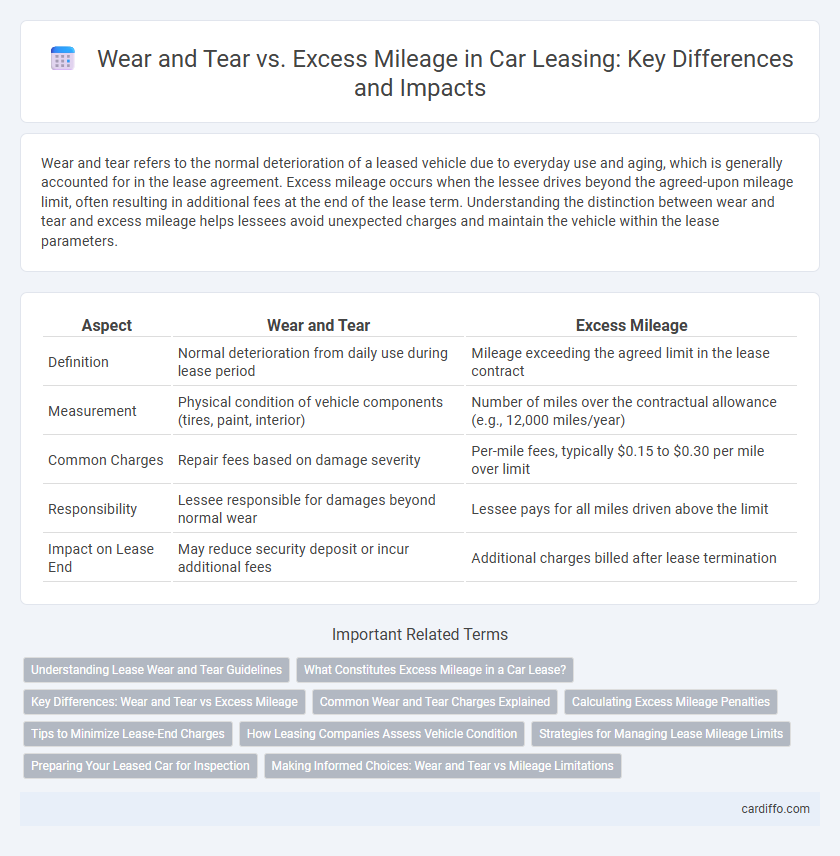Wear and tear refers to the normal deterioration of a leased vehicle due to everyday use and aging, which is generally accounted for in the lease agreement. Excess mileage occurs when the lessee drives beyond the agreed-upon mileage limit, often resulting in additional fees at the end of the lease term. Understanding the distinction between wear and tear and excess mileage helps lessees avoid unexpected charges and maintain the vehicle within the lease parameters.
Table of Comparison
| Aspect | Wear and Tear | Excess Mileage |
|---|---|---|
| Definition | Normal deterioration from daily use during lease period | Mileage exceeding the agreed limit in the lease contract |
| Measurement | Physical condition of vehicle components (tires, paint, interior) | Number of miles over the contractual allowance (e.g., 12,000 miles/year) |
| Common Charges | Repair fees based on damage severity | Per-mile fees, typically $0.15 to $0.30 per mile over limit |
| Responsibility | Lessee responsible for damages beyond normal wear | Lessee pays for all miles driven above the limit |
| Impact on Lease End | May reduce security deposit or incur additional fees | Additional charges billed after lease termination |
Understanding Lease Wear and Tear Guidelines
Lease wear and tear guidelines distinguish between normal usage and damages exceeding standard expectations, ensuring lessees are not unfairly penalized for everyday vehicle use. Excess mileage charges apply when a lessee surpasses the mileage limit set in the lease agreement, often resulting in additional fees based on the per-mile rate specified. Properly understanding lease agreements and documenting vehicle condition at lease inception can help avoid disputes over wear and tear and excess mileage charges.
What Constitutes Excess Mileage in a Car Lease?
Excess mileage in a car lease refers to any miles driven beyond the agreed-upon limit specified in the lease contract, typically ranging from 10,000 to 15,000 miles per year. Lease agreements impose a per-mile charge, often between $0.15 and $0.30, for each mile exceeding the allowance, which can significantly increase end-of-lease costs. Understanding the exact mileage limit and calculating estimated driving needs helps avoid costly excess mileage penalties and maintain budget control.
Key Differences: Wear and Tear vs Excess Mileage
Wear and tear refers to the natural deterioration of a leased vehicle due to normal use over time, while excess mileage pertains to driving beyond the agreed contractual limit. Wear and tear typically includes minor scratches, tire wear, and interior fading, whereas excess mileage results in financial penalties based on the number of miles driven over the stipulated cap. Understanding these distinctions is crucial for lessees to avoid unexpected charges at lease-end.
Common Wear and Tear Charges Explained
Common wear and tear charges in lease agreements typically cover minor damages such as light scratches, small dents, and tire wear that occur during normal use. Excess mileage fees are separate costs applied when the vehicle's mileage exceeds the agreed limit, often charged per additional mile. Understanding these distinctions helps lessees avoid unexpected charges at lease-end inspections.
Calculating Excess Mileage Penalties
Excess mileage penalties are calculated based on the difference between the actual miles driven and the allowed mileage specified in the lease agreement, typically charged per mile over the limit. Wear and tear charges apply separately and cover damages beyond normal use, assessed during vehicle inspection at lease end. Accurate tracking of mileage and vehicle condition throughout the lease term helps avoid unexpected excess mileage fees and wear-related costs.
Tips to Minimize Lease-End Charges
Regularly scheduled maintenance and timely repairs reduce excessive wear and tear on leased vehicles, preventing costly end-of-lease penalties. Monitoring mileage to stay within the agreed limits helps avoid excess mileage charges, which can significantly increase the total lease cost. Using protective seat covers and parking in shaded areas further preserves the vehicle's condition, minimizing potential charges.
How Leasing Companies Assess Vehicle Condition
Leasing companies assess vehicle condition by distinguishing between normal wear and tear and excess mileage, using detailed inspection guidelines to evaluate damages such as minor dents, scratches, and tire wear within acceptable limits. Excess mileage charges are calculated based on the contract's stipulated mileage allowance, with fees applied per mile exceeding the agreed threshold. Thorough end-of-lease inspections ensure accurate assessment, balancing standard depreciation against penalties for excessive use beyond normal wear.
Strategies for Managing Lease Mileage Limits
Effective strategies for managing lease mileage limits include monitoring odometer readings regularly to avoid excess mileage penalties, negotiating higher mileage allowances at the lease inception, and planning trips efficiently to reduce unnecessary driving. Utilizing telematics or mileage tracking apps can provide accurate data, helping lessees stay within their contractual limits and avoid costly fees. Considering lease-end options such as mileage overage buybacks or lease extensions can also mitigate financial risk associated with exceeding mileage caps.
Preparing Your Leased Car for Inspection
Preparing your leased car for inspection requires careful attention to distinguishing between normal wear and tear and excess mileage charges. Inspect tires, brakes, and interior for damage beyond typical use, as excessive scuffs, dents, or stains can result in additional fees. Keep detailed mileage records to ensure you stay within your lease agreement limits, avoiding costly penalties for excess mileage.
Making Informed Choices: Wear and Tear vs Mileage Limitations
Understanding the differences between wear and tear and excess mileage charges is crucial for lease agreements to avoid unexpected costs. Wear and tear refers to the normal depreciation of the vehicle's condition during the lease term, while excess mileage fees are imposed when the mileage exceeds the contractually agreed limits. Choosing a lease plan with realistic mileage allowances and maintaining the vehicle properly helps minimize excess fees and balancing these factors supports more informed financial decisions.
Wear and Tear vs Excess Mileage Infographic

 cardiffo.com
cardiffo.com